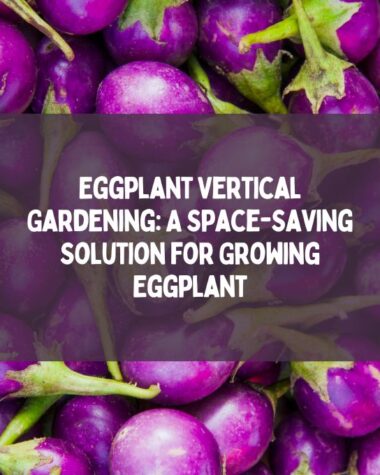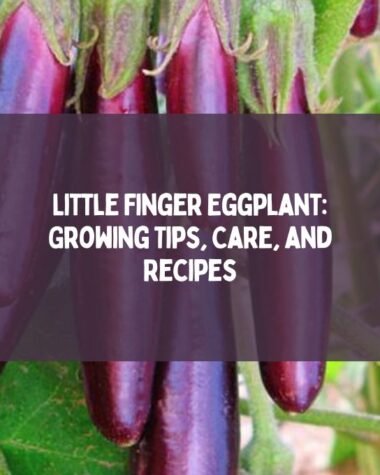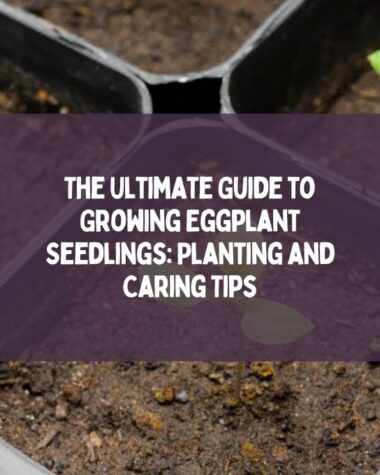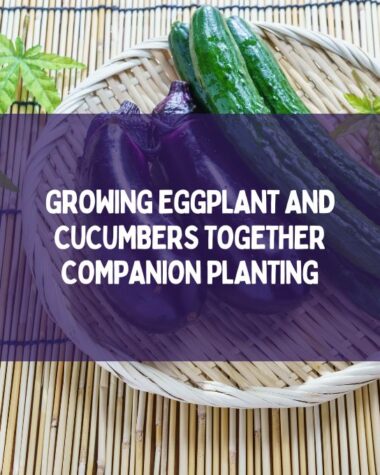Aubergines are an incredibly rewarding vegetable to grow in your own backyard. Not only do they provide tons of tasty dishes from fried eggplant parmesan to ratatouille, but their unique purple color gives any garden an exciting splash of vibrancy
Are you looking to add some delicious aubergine to your garden? Planting and growing the perfect Aubergine or eggplant is easier than it seems.
With this Complete Aubergine Planting Guide, I’ll walk you through all of the steps necessary for a successful harvest. From selecting the right variety to harvesting at just the right time, I’ve got all the tips and tricks that make planting eggplants easy!
So let’s get started. By following my step-by-step instructions, you’re sure to have juicy, flavorful eggplants ready for harvest in no time!
Selecting An Aubergine Variety

When selecting a variety of aubergine to plant, there are a few things to consider.
Size and Shape
First, think about the size and shape you want. Heirloom varieties tend to be more flavorful than hybrids but may take longer to grow. If you’re looking for something fast-growing and uniform in appearance, hybrids may be the better choice.
Consider Space
Next, consider how much space you have available for planting. Eggplants or Aubergine need a lot of room. So if you don’t have a large area to work with, opt for smaller varieties like Fairy Tale or Patio Baby. These can easily fit into small containers or raised beds.
Climate
Finally, take climate into account when selecting an Aubergine variety. Some types require warm weather and will not survive cold temperatures. In cooler climates, choose varieties that are bred for short growing seasons such as White Star or Black Beauty.
By taking these factors into consideration when choosing your eggplant variety, you’ll be able to get the best results from your garden this season!
How to Plant Aubergine (A Step-by-Step Guide)

Planting aubergine is a great way to add fresh produce to your garden or home. With a little bit of preparation and care, you can grow your own eggplants right in your backyard.
In this step-by-step guide, I’ll walk you through the process of planting eggplant and give you tips to help you achieve a bountiful harvest.
Step 1: Choose the right location
Choose a sunny spot in your garden that receives at least 6 hours of direct sunlight each day. Eggplants need warm weather and thrive in temperatures between 70 and 85°F. The location should also have well-drained soil with a pH between 5.5 and 7.0.
Step 2: Prepare the soil
Eggplants prefer loose, well-drained soil. Begin by removing any rocks, weeds, or debris from the area. Then, mix in compost or aged manure to improve the soil’s fertility and structure. Add a slow-release fertilizer, following the package’s instructions.
Step 3: Plant the Aubergine
Sow the Aubergine seeds in late winter or early spring, indoors. Fill a seed tray with seed-starting soil, and plant two to three seeds per cell, covering them with a thin layer of soil. Keep the soil consistently moist, and ensure the temperature stays between 20°C to 30°C. Seedlings will emerge in about 10 to 14 days.
Step 4: Plant Seedlings into Pots
Once the seedlings are a few inches tall and have their first true leaves, transplant them into individual pots, burying them up to their first set of leaves. This will promote strong root growth.
When the danger of frost has passed and the outdoor temperature remains consistently above 60°F, transplant the seedlings outdoors, spacing them 18 to 24 inches apart.
Step 5: Care for the plants
Eggplants need regular watering, especially during dry spells. Water the plants deeply, so the soil is moist at a depth of about 6 inches. Mulch around the plants to conserve moisture and suppress weed growth.
As the aubergine grows, support them with stakes or cages to keep them upright. Pinch off the growing tips when the plants reach about 18 inches tall, which will encourage branching and more fruit production. Apply a balanced fertilizer every three to four weeks during the growing season.
Step 6: Harvest the eggplants
Aubergines are ready to harvest when they’re shiny, firm, and smooth, and their skin has a glossy appearance. Use pruning shears or a sharp knife to cut the eggplants from the stem. If you don’t harvest the eggplants regularly, they’ll become overripe, making them bitter and inedible.
To sum up, planting eggplants can be a fun and rewarding experience. By following these simple steps, you’ll be able to grow your own eggplants and enjoy the taste of fresh produce straight from your garden.
Related Reading:
When To Plant Aubergine For Best Harvest?
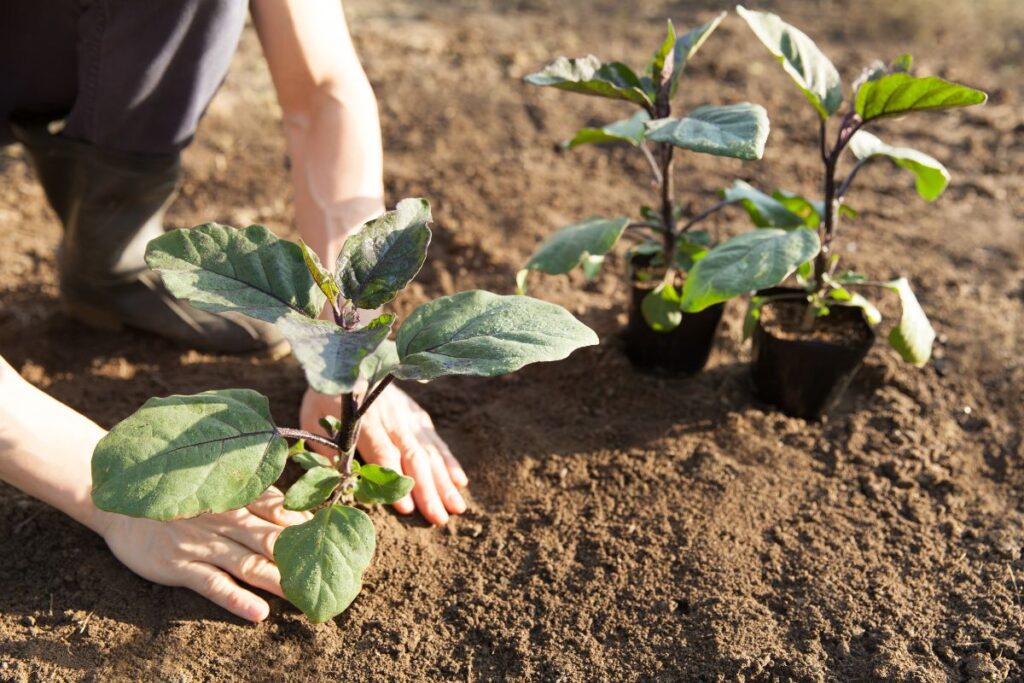
Planning when to plant Aubergine is the key to a successful aubergine harvest. The best time to plant Aubergine depends on your local climate and conditions. But, generally speaking, it’s advised you start in late spring or early summer.
Typically, this corresponds with temperatures of at least 18°C (65°F). Eggplant planting season can begin as early as April in warm climates, while in cooler areas should wait until May before starting. Aubergine planting time also needs to take into account how long the plants will need to reach maturity.
Some aubergine varieties require up to 80 days from sowing seeds to harvesting fruit! To get an accurate idea of when you should be sowing your eggplants, research what type of variety you’re growing and check the average temperature for your area during the spring-summer months.
Planting too early may result in stunted growth due to cold weather, which could ruin your harvest. Proper timing helps ensure that you’ll have ample fruits come autumn!
What Is Aubergine Germination Time?
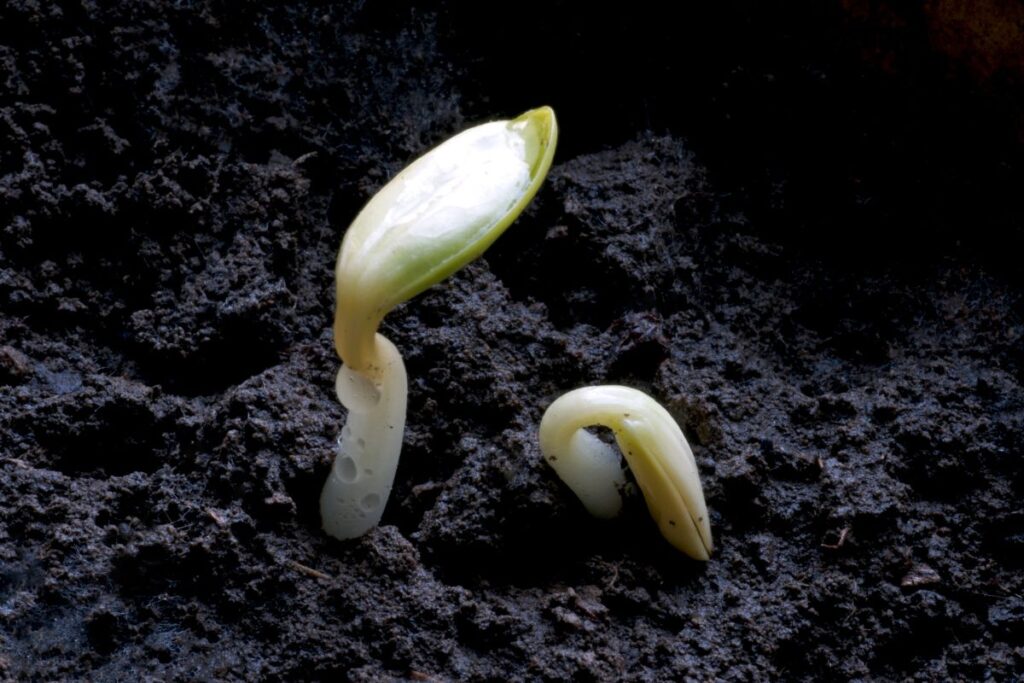
Now that you know when to plant eggplants for the best harvest, it’s time to understand what aubergine germination time involves. Germination is a crucial part of growing an eggplant successfully, and understanding how long the process takes will help ensure you are successful in your gardening endeavor.
Here is an overview of aubergine germination time:
- Seed Germination Time: Seeds typically take 3-7 days to germinate under ideal conditions.
- Seedling Germination Time: After seeds have sprouted, seedlings can take up to two weeks or more before they reach transplanting size.
- Aubergine Seed Germination Conditions: Eggplants need warm soil temperatures (70-90 degrees F) and moist dirt to germinate properly.
- Aubergine Seedling Germination Temperature: As seedlings start to emerge from the ground, keep soil temperature at 70-85 degrees F for optimal growth.
- Soil Moisture Level: To ensure proper seed and seedling germination, maintain consistent moisture levels in your soil by watering regularly.
It’s important to note that if environmental factors like temperature and humidity don’t align with those mentioned above, this could affect overall germination times or even prevent them from occurring altogether.
By taking these steps into account during every stage of planting and caring for your aubergines, you will be well on your way toward achieving success in your garden!
How To Grow Eggplant From Seed?

Growing aubergines from seed is a rewarding process. To get started, you’ll need to find high-quality seeds that are well-suited for the climate in your area. Once you have your seeds, it’s time to begin the germination process.
- You’re about to embark on an exciting journey
- The reward of seeing healthy plants sprout up will bring joy and satisfaction.
- Watching them grow and produce fruits can be incredibly satisfying!
- Finally being able to enjoy the delicious fruit of your labor can be immensely gratifying.
First, place the aubergine seeds in a warm bowl of water overnight so they can absorb moisture before planting. This helps speed up their germination process significantly, as it gives them access to vital nutrients found in soil later on when planted outdoors or indoors in containers.
Then, fill each container with potting soil and mark where each seed should go using a stick or marker. Place two or three seeds per container at least one inch deep into the soil and cover lightly with additional potting mix.
Water regularly until shoots appear. This usually takes around 10 days, depending on temperature levels and humidity. Then thin out any extra shoots if there is more than one growing from a single spot.
Once established, give your aubergine plants plenty of sunlight and keep them moist but not soggy. Too much water could lead to root rot or other problems like insects attacking them due to a lack of oxygenated air pockets within the soil structure.
Add fertilizer every few weeks during the growing season but avoid over-fertilizing which can cause burning foliage leaves.
What is Ideal Aubergine Plant Spacing?
When planting aubergines, it’s important to take the spacing of each plant into account. Planting them too close together can lead to overcrowding and competition for resources like water or sunlight. On the other hand, giving them too much space can result in inefficient use of your garden bed and make harvesting difficult.
Here are a few tips on aubergine plant spacing:
- Plant seeds at least 20 cm apart, increasing the distance by 25-30 cm if you’re growing large varieties of eggplant.
- If planting transplants, give plants room to spread out as they grow. This could mean up to 45 cm between mature specimens.
- Consider how big your variety typically grows before deciding on an appropriate distance; some may reach heights of 1 meter!
Always remember that correct plant spacing is key when it comes to successful aubergine cultivation. When done correctly, you’ll get more abundant harvests with fewer issues within the crop itself.
Are Aubergines Easy To Grow?
Growing aubergines can be quite rewarding. However, it does come with some challenges. While the actual process of growing an aubergine isn’t difficult, there are a few things to keep in mind if you want to ensure success.
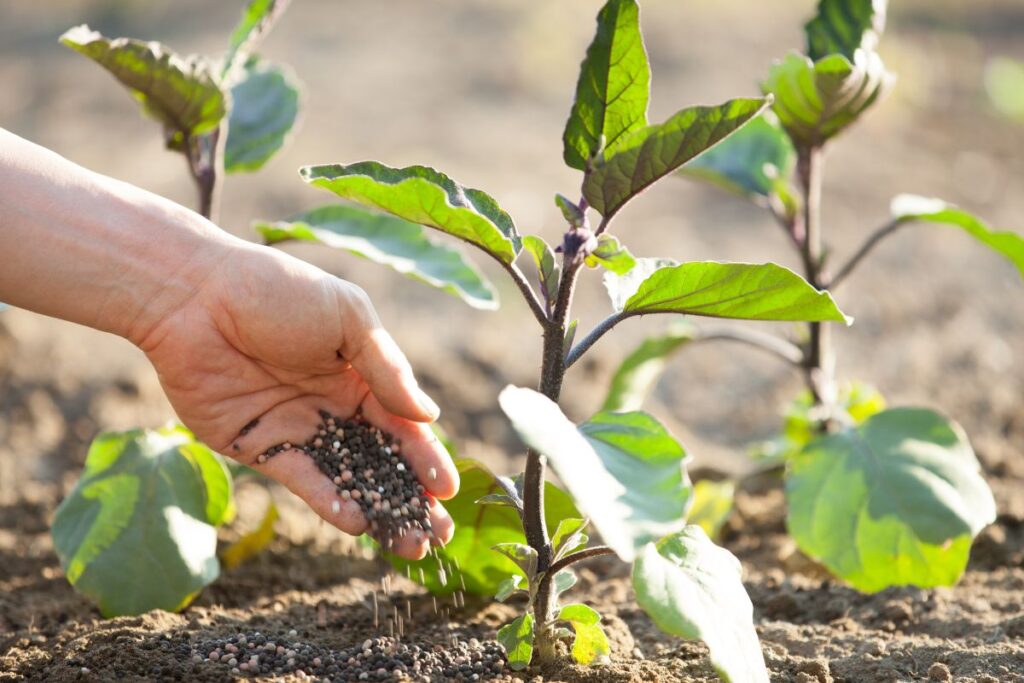
One of the biggest issues when it comes to growing aubergines is ensuring they get enough water without becoming overwatered. Aubergines like consistently moist but not soggy soils. It means watering regularly during dry spells but allowing the soil time to dry out between waterings.
If your climate gets very hot for extended periods, mulching around the base of the plant will help retain moisture in the soil and reduce stress on the plant from extreme heat.
How Long Does It Take To Grow Aubergines?
The growth time necessary for producing aubergines is contingent on the type of eggplant being grown and its climate and soil conditions. Generally, it takes around 80 to 120 days from planting until harvest.
The table below outlines an approximate timeline for different varieties of aubergine:
| Variety | Approximate Days to Maturity |
| Early-Season Eggplants | 45 – 50 days |
| Mid-Season Eggplants | 65 – 70 days |
| Late-Season Eggplants | 85 – 95 days |
Do Aubergine Plants Need Support?
Now that we’ve answered the question of how long it takes to grow aubergines, let’s address whether or not they need support.
Aubergine plants are typically quite tall and can reach heights between 1 and 2 meters. It means they often require some kind of plant support structure for stability. Without this additional form of support, the vines will droop from their own weight and place a strain on other parts of the plant, such as stalks and stems.
When it comes to providing an external form of reinforcement for an aubergine plant, there are several approaches you can take.
Here is a popular option for aubergine plant support.
Aubergine Staking
One popular option is to employ something called ‘aubergine staking, which involves placing stakes around the base of your plants in order to provide them with extra vertical support. If you opt for this method, make sure your stakes are sturdy enough so that they don’t bend or break under pressure.
The best materials include bamboo poles, metal rods, or wooden posts, depending on what you have available. Plant ties should be used at intervals along the stake in order to keep the vine firmly attached without damaging it. Nylon string works well here too.
In addition to using stakes for larger plants, smaller ones may benefit from cages or trellises. It offers more protection against strong winds and heavy rains throughout the growing season.
These structures also help prevent any fruits from becoming bruised by being knocked off branches during stormy weather conditions. However, if you choose this route, then ensure your cage has plenty of air circulation so as not to restrict growth too much.
In the end, though, giving aubergines the right care is the only way to make sure they grow well and produce good crops.
How Many Aubergines Per Plant?
When planting aubergines, it’s important to consider the size and number of plants that will produce a successful yield. The number of eggplants per plant can vary significantly depending on many factors, such as soil fertility and irrigation.
Generally speaking, one should aim for an average of 5 to 6 aubergines per plant when grown in a small garden bed or container.
In larger fields with more favorable conditions, however, yields may be higher. In this case, three to six aubergines per plant are recommended. When growing in ideal circumstances like these, growers may find they need fewer plants to achieve their desired yield.
It’s also important to keep in mind that not all of the fruit that a plant produces will ripen completely. Some fruits might fall off early due to pests or unfavorable weather.
To ensure healthy growth and high-quality aubergine yields, it’s necessary to keep track of the number of plants being grown and the expected output from each individual one. This lets you plan your harvest well and get the most out of your crops throughout the season.
Can I Grow Aubergines In Pots?
Yes, you can grow aubergines in pots! If you plan to do so, it’s important to understand the basics of growing them successfully.
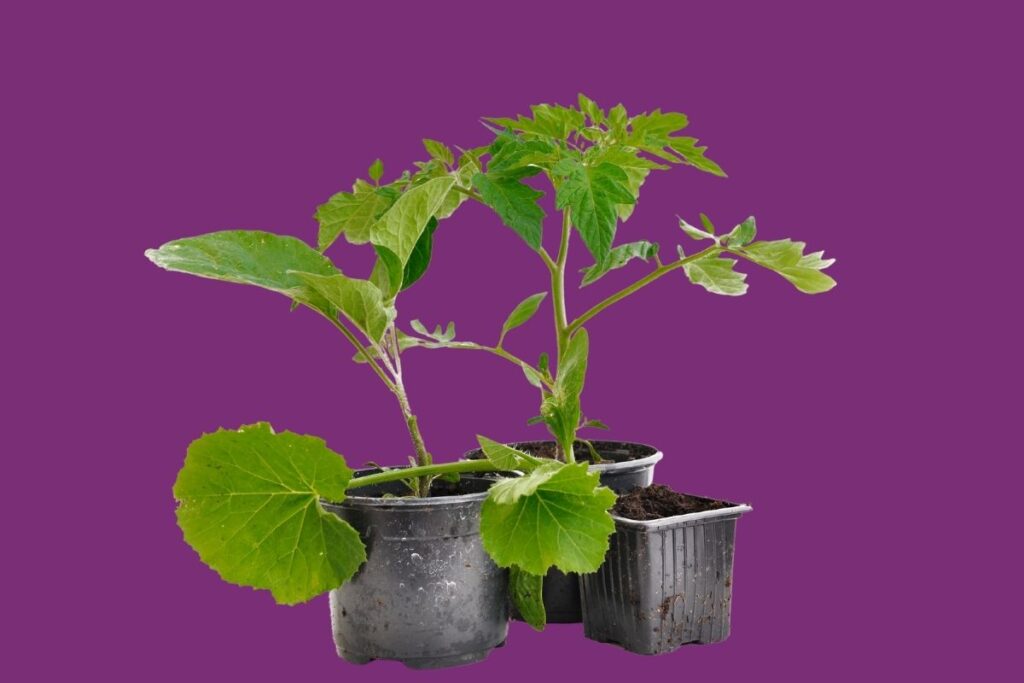
Here’s how can you grow aubergines or eggplants in pots.
- To begin with, make sure that your pot size is large enough for the plant.
- A pot should be at least 18 inches deep and wide.
- Also, use a good quality potting mix specifically designed for container gardening.
- If you plant an eggplant in a pot or container, regular soil won’t drain and feed it well enough.
- When choosing a potting mix for your aubergine plant, look for one that contains composted organic matter like peat moss or coir fiber.
- When planting aubergines in containers, place two or three seeds per hole about 1/2 inch deep.
- Keep seedlings well-watered, but don’t let them sit in waterlogged soil, as this will cause root rot.
- Keep the soil moist by watering it often during dry times and putting mulch around plants often to stop water from evaporating from the top of the soil.
When growing aubergines in pots, you have more control over the temperature and environment than when you plant them outside. Provide shade during hot days and protection against heavy rains or windy conditions to ensure the healthy growth of your eggplants throughout their life cycle.
Related Reading:
Tips For Successfully Growing Aubergine Plants
Now that you know it is possible to grow aubergines in pots, let’s look at some tips for ensuring your plants are successful. Growing eggplants can be a rewarding experience if done correctly; here are the most important steps.
Preparing the Soil
- Test the soil pH levels and make sure they fall between 6-6.8 by adding fertilizer or lime as needed.
- Mix compost into the soil before planting to improve drainage and add nutrients.
- Incorporate a good amount of organic material such as manure or peat moss to enrich the soil.
Planting Your Eggplant
- Place transplants 2 feet apart in rows 3 feet apart with each plant facing east towards the sun.
- Mulch around the plants after planting to help conserve moisture and control weeds.
- Water deeply once every 7-10 days during dry weather until harvest time.
Pruning and Pest Prevention
- Remove any healthy shoots that appear below the main stem of your aubergine plant so energy will go toward producing fruit instead of leaves and stems.
- Inspect plants regularly for signs of pests, such as aphids and mites, and treat them accordingly with natural pesticides if necessary.
By following these simple steps for preparing the soil, planting your eggplant, pruning, and pest prevention, you should have no problem growing healthy aubergine plants in containers!
How To Harvest Aubergines?
Harvesting aubergines is a straightforward process, but one that requires patience and attention to detail. At the end of the growing season, when the fruit has reached its full size and color, it’s time to start picking!
It’s important not to choose fruits that are too ripe or overripe since they won’t have as many nutrients left in them. The best way to tell if an eggplant is ready for harvest is by gently squeezing it. If it yields easily under pressure, then it should be harvested right away.
- In addition to harvesting at the right moment, there are some other tips you can follow while selecting your aubergines.
- Look out for any signs of disease or pests on the plants, such as discoloration or wilting leaves. These could indicate an infestation and cause damage to your crop.
- Also check for misshapen fruits, which usually mean that something isn’t quite right with the plant itself.
- Finally, make sure to cut off each stems with scissors rather than pull the fruit from its vine; this will help reduce any potential damage done to both the plant and the fruit during harvesting.
If you pick aubergines the right way, your garden plot will produce a lot of tasty food. With just a bit of extra care and attention taken when harvesting your crops, you’ll soon have an abundance of vibrant vegetables ready for eating!
Are There Any Pests Or Diseases That Can Affect Eggplant Growth?
When it comes to eggplant growth, pests, and diseases can have a huge impact. So it’s important for gardeners to understand the potential issues that may arise when planting this vegetable crop.
Here are some key points to consider:
- Identifying and controlling common eggplant pests
- Recognizing signs of eggplant diseases
- Strategies for pest control and disease management
- Monitoring your plants regularly
As an expert in eggplants/aubergines, I highly recommend that all growers familiarize themselves with the types of pests and diseases that could affect their crops.
Common insect pests include aphids, flea beetles, Colorado potato beetles, whiteflies, thrips, and mites. These insects can cause direct damage by feeding on plant parts or indirectly by spreading viral or fungus infections.
If left unchecked, they can stunt plant growth and reduce yields drastically.
By taking preventive measures such as proper identification of pests and frequent surveillance of your plants, you will go a long way towards ensuring successful harvests year after year!
Related Reading:
Growing Carrots In The South During The Summer Heat
Conclusion
As an expert on planting eggplant, I can say with certainty that if you follow the steps in this guide, you will get a good harvest. Aubergines do best when they are planted in soil that drains well, are watered often, and get enough sunlight.
Overall, if you plant eggplants properly according to their needs, you’ll have no problem harvesting delicious fruits at the end of the season! With proper care and attention, anyone can become an expert on eggplant.
Happy planting!
Frequently Asked Questions
What Type Of Soil Is Best For Growing Eggplants?
When it comes to eggplant planting, the type of soil is essential for successful growth. It should be nutrient-rich and well-draining so that the plants can develop healthy root systems. Therefore, it’s important to prepare your soil before you start planting eggplants.
What Is The Optimal Temperature For Growing Eggplants?
The optimal temperature for eggplant growth ranges from 65 to 95°F (18 to 35°C).
How Often Should Eggplants Be Watered?
In general, eggplants require frequent watering with smaller amounts at regular intervals. This helps prevent shock from being overwatered and keeps soil moisture levels consistent. Depending on the climate and temperature you’re growing in, as well as your soil type, the exact watering schedule may vary slightly.
How Much Sunlight Do Eggplants Need?
Eggplant plants require a minimum of 6 hours of sun exposure in order to produce healthy fruits. Depending on where you live, the amount and duration of sunlight your eggplants will be exposed to can vary significantly.

